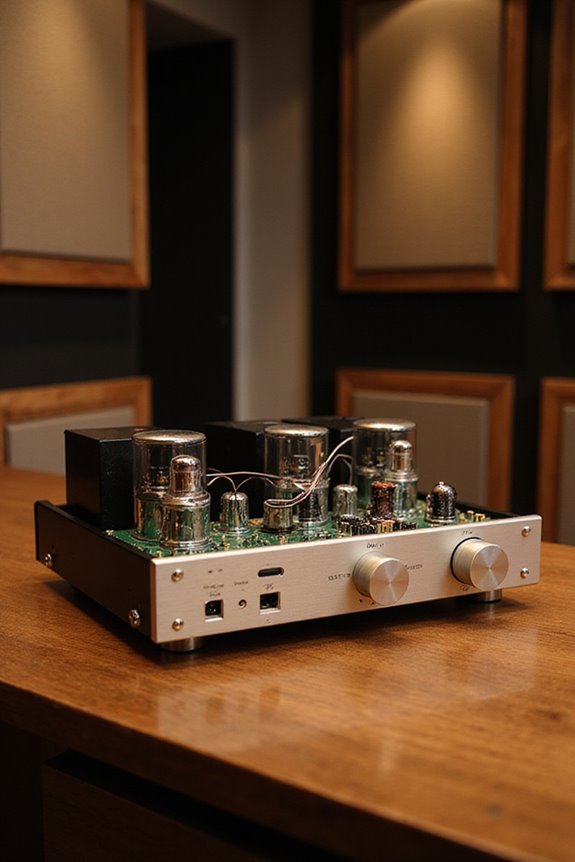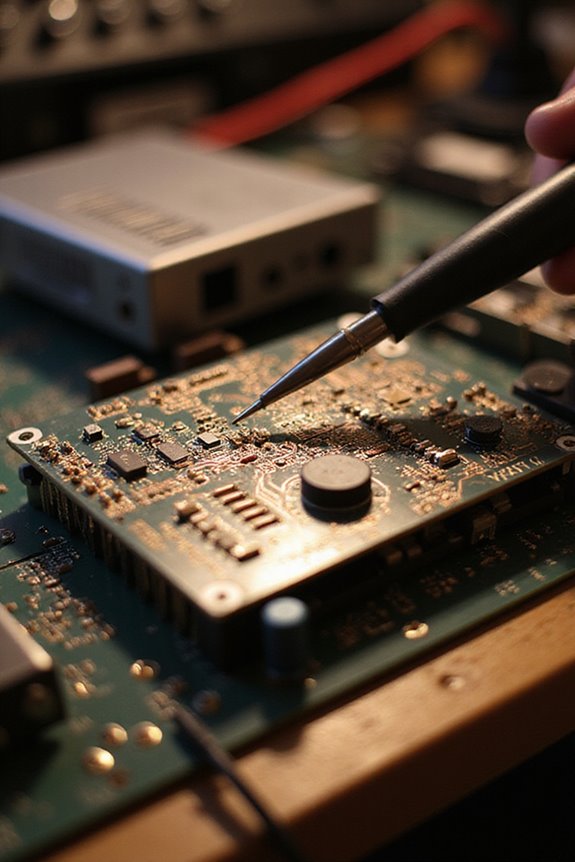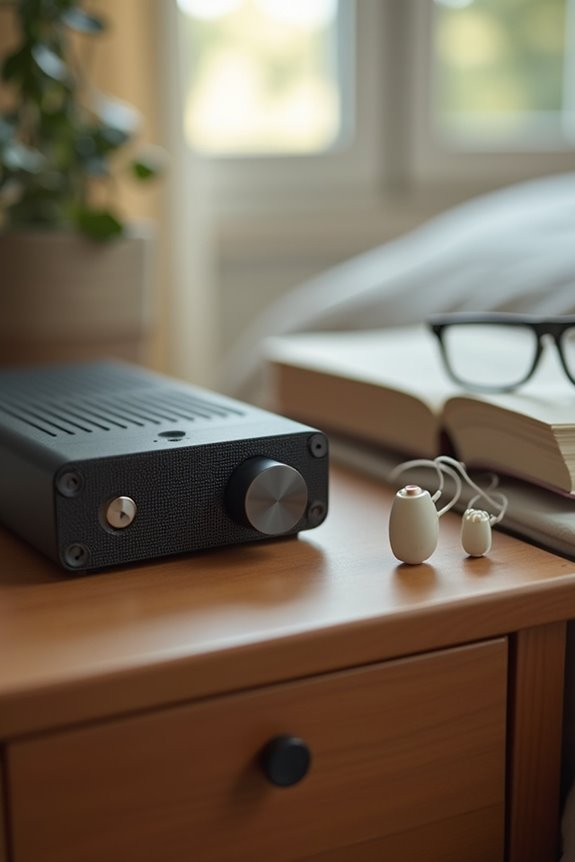Sound amplifiers are categorized into classes based on their architecture and performance characteristics.
- Class A: High linearity, low distortion, efficiency 15-35%.
- Class B: Higher efficiency (~70%), suffers from crossover distortion.
- Class AB: Strikes a balance, efficiency 50-70%.
- Class D: Over 90% efficiency with potential audio fidelity trade-offs.
Applications range from professional sound systems to home theaters. Additional insights on advancements in sound amplification technologies are available for further exploration.
Key Takeaways
- Amplifier classes (A, B, AB, D, G, H) vary in efficiency and sound quality, impacting their application suitability.
- Class A amplifiers provide high fidelity with minimal distortion, ideal for low power devices and studio use.
- Class B amplifiers prioritize efficiency for professional sound reinforcement but face crossover distortion issues.
- Class D amplifiers exceed 90% efficiency, making them suitable for high-power audio applications despite potential sound fidelity compromises.
- Innovations like AI optimization and spatial audio enhance amplifier performance and user experience in modern audio systems.
What Are the Different Classes of Amplifiers and Their Characteristics?
Understanding the different classes of amplifiers is essential for selecting the appropriate device for specific audio applications. The main amplifier types include:
- Class A: Operates with a 360° conduction angle, ensuring high linearity and low distortion. However, efficiency is low (15–35%), generating significant heat.
- Class B: Features a 180° conduction angle using two transistors in a push-pull configuration. It achieves higher efficiency (around 70%) but suffers from crossover distortion.
- Class AB: Merges Class A and B characteristics, conducting between 180° to 360°. It balances fidelity and efficiency, typically around 50–70%.
- Class D: Employs pulse width modulation for over 90% efficiency, but may compromise audio fidelity.
- Class G and H: Enhance efficiency beyond Class AB through dynamic voltage modulation.
How Do Amplifier Designs Affect Sound Quality?

Amplifier design greatly affects sound quality, as various configurations and technologies influence fidelity and performance.
Key Factors Influencing Sound Quality
- Amplifier Topology: Different topologies, such as push-pull and single-ended, determine how signals are processed.
- Distortion Types: Class B amplifiers may introduce crossover distortion, while Class A designs minimize distortion, offering superior sound fidelity.
- Signal Processing: Advanced techniques like feedforward error correction enhance linearity, albeit at the cost of increased complexity.
- Efficiency Trade-offs: Higher efficiency classes (e.g., Class D) excel in power conservation but may compromise sound purity.
Conclusion
Understanding these factors is essential for selecting an amplifier that aligns with desired sound fidelity and performance standards.
What Are the Applications of Various Amplifier Classes?

The application of various amplifier classes plays a significant role in audio technology, influencing both performance and efficiency.
Class A Amplifiers
- Ideal for low power devices like radios and outdoor sound systems.
- Offers high signal fidelity with minimal distortion.
Class B Amplifiers
- Common in professional sound reinforcement, prioritizing efficiency.
- Prone to crossover distortion, limiting pure Class B use.
Class AB Amplifiers
– Favored in home theater systems for balancing efficiency and sound quality.
Class D Amplifiers
- Achieves over 90% efficiency through pulse width modulation (PWM).
- Suitable for high-power audio applications.
Class G/H Amplifiers
- Enhanced efficiency with dynamic power supply variations.
- Effective in high-output scenarios.
Each of these amplifier types demonstrates unique circuit design features tailored to specific applications.
What Are the Trade-offs Between Efficiency and Sound Fidelity?

How do the trade-offs between efficiency and sound fidelity manifest in various amplifier designs?
- Efficiency vs. Sound Quality: Higher efficiency often results in harmonic distortion and potential digital artifacts. For instance, Class D amplifiers can achieve 80–95% efficiency but may compromise sound fidelity.
- Class A Amplifiers: Known for minimal distortion and maximum linearity, they operate at only 20–40% efficiency, making them suitable for studio applications where sound quality is prioritized.
- Power Consumption: Efficient designs reduce power consumption, allowing for compact devices, while less efficient models like tube amplifiers enhance perceived sound quality but at a higher energy cost.
What Innovations Are Shaping the Future of Sound Amplification?

Innovations in sound amplification are being driven by advancements in technology, pushing the boundaries of performance and efficiency. Key developments include:
- AI Optimization: Smart amplifiers utilize AI algorithms for auto-tuning and adaptive control, enhancing sound output based on user preferences and environmental factors.
- Spatial Audio: Advanced algorithms create immersive experiences by mapping sound in 3D, greatly benefiting gaming and virtual reality applications.
- Miniaturization: New materials reduce the physical footprint of amplifiers while improving power handling and efficiency, making them suitable for compact devices.
- Connectivity: Enhanced compatibility with IIoT ecosystems and smart home platforms supports seamless integration and real-time data sharing.
These innovations collectively enhance user experience, catering to modern demands for performance, convenience, and sustainability.
Frequently Asked Questions
How Do I Choose the Right Amplifier for My Needs?
When selecting the right amplifier, one must consider amplifier types and their impact on sound quality. Understanding personal preferences and specific applications guarantees a choice that enhances the listening experience and fosters a sense of belonging within the audio community.
Can Amplifiers Work With Any Type of Speaker?
Could amplifiers work seamlessly with any speaker? The answer lies in speaker compatibility and amplifier types. A mismatch could lead to damage, emphasizing the importance of understanding specifications for ideal performance and a harmonious listening experience.
What Is the Impact of Impedance on Amplifier Performance?
Impedance greatly influences amplifier performance, with proper impedance matching enhancing audio clarity. Mismatched impedance can lead to distortion and reduced dynamic range, underscoring the importance of compatibility for ideal sound quality and equipment longevity.
How Do I Connect an Amplifier to My Audio Source?
How does one bridge the gap between an audio source and an amplifier? Connection methods vary, but ensuring compatibility and secure links fosters a shared musical experience, enhancing the bond between listeners and their sound systems.
Are There Specific Brands Known for High-Quality Amplifiers?
Many popular brands, such as Crown, QSC, and Cambridge Audio, are recognized for their high-quality amplifiers. These brands offer features like advanced DSP, efficient power management, and user-friendly designs, appealing to both professionals and enthusiasts seeking superior sound.





